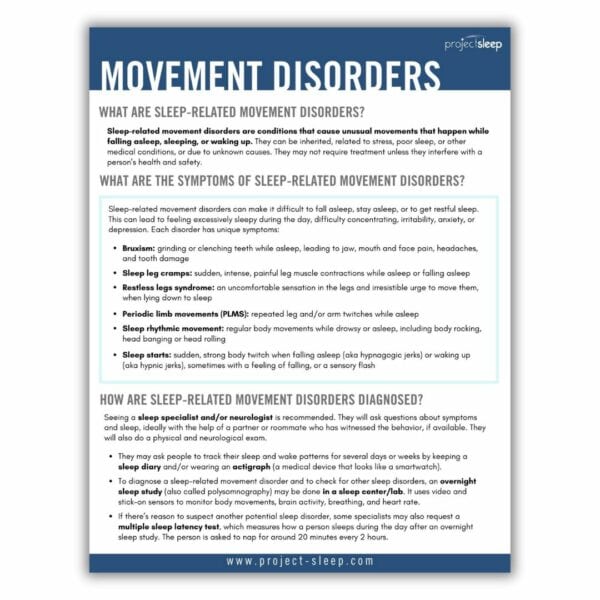Sleep-related movement disorders are conditions that cause unusual movements that happen while falling asleep, sleeping, or waking up.
Sleep-Related Movement Disorders
What are sleep-related movement disorders?
Sleep-related movement disorders are conditions that cause unusual movements that happen while falling asleep, sleeping, or waking up. They can be inherited, related to stress, poor sleep, or other medical conditions, or due to unknown causes. They may not require treatment unless they interfere with a person’s health and safety.
Sleep-related movement disorders may be inherited or due to other causes.
What are the symptoms of sleep-related movement disorders?
Sleep-related movement disorders can make it difficult to fall asleep, stay asleep, or get restful sleep. This can lead to feeling excessively sleepy during the day, difficulty concentrating, irritability, anxiety, or depression. Each disorder has unique symptoms.
Bruxism: grinding or clenching teeth while asleep, leading to jaw, mouth and face pain, headaches, and tooth damage
Sleep leg cramps: sudden, intense, painful leg muscle contractions while asleep or falling asleep
Restless legs syndrome (RLS): an uncomfortable sensation in the legs and irresistible urge to move them, when lying down to sleep
Periodic limb movements (PLMS): repeated leg and/or arm twitches while asleep
Sleep rhythmic movement: regular body movements while drowsy or asleep, including body rocking, head banging or head rolling
Sleep starts: sudden, strong body twitch when falling asleep (aka hypnagogic jerks) or waking up (aka hypnic jerks), sometimes with a feeling of falling, or a sensory flash
How are sleep-related movement disorders diagnosed?
Seeing a sleep specialist and/or neurologist is recommended for people experiencing unusual movements while falling asleep, sleeping, or waking up.
A sleep specialist will ask questions about your symptoms and sleep, ideally with the help of a partner or roommate who has witnessed the behavior, if available. They will also perform a physical and neurological exam.
The sleep specialist may ask patients to track their sleep and wake patterns for several days or weeks by keeping a sleep diary and/or wearing an actigraph (a medical device that looks like a smartwatch). To diagnose a sleep-related movement disorder and to check for other sleep disorders, an overnight sleep study (also called polysomnography) may be done in a sleep center/lab. It uses video and stick-on sensors to monitor body movements, brain activity, breathing, and heart rate.
If there’s reason to suspect another potential sleep disorder, some specialists may also request a multiple sleep latency test, which measures how a person sleeps during the day after an overnight sleep study. For this test, the person is asked to nap for around 20 minutes every 2 hours.
How are sleep-related movement disorders treated?
Sleep-related movement disorders may not need treatment, especially in children, unless they are frequent, could result in injury, or make it difficult to get a good night’s sleep. The best choice of treatments for each person depends on the type and cause of the disorder.
Depending on the disorder, helpful lifestyle strategies could include safety measures (e.g. padding sharp bedroom furniture), avoiding caffeine and alcohol in the evening, reducing stress, staying hydrated, daily exercise and stretching, massage or hot showers before bed, and loosening tucked sheets.
For bruxism, mouth guards can protect teeth.
Other health conditions, including sleep disorders and mental health issues, could be contributing to symptoms and are important to treat.
Connecting with other people who have a sleep-related movement disorder and their families can empower people to learn helpful strategies for living well.
Medications used to treat sleep-related movement disorders in adults include iron supplements, medications typically used to treat anxiety, depression, or seizures, medications that increase dopamine levels in the brain, and opioids.
Additional Resources
Please download our free, printable Sleep-Related Movement Disorders Fact Sheet for a handy resource to share with friends, family, and medical providers.

